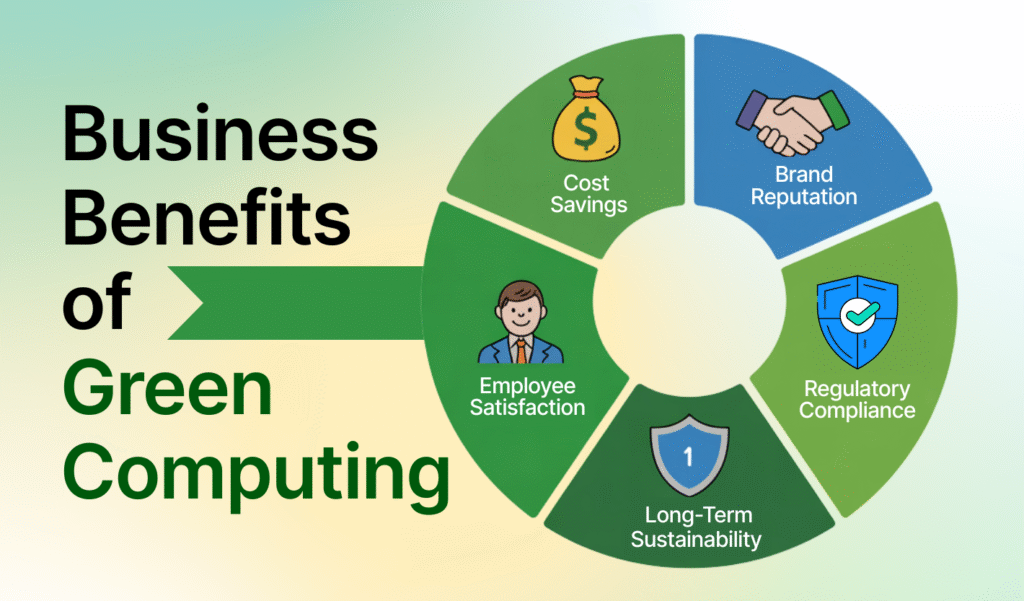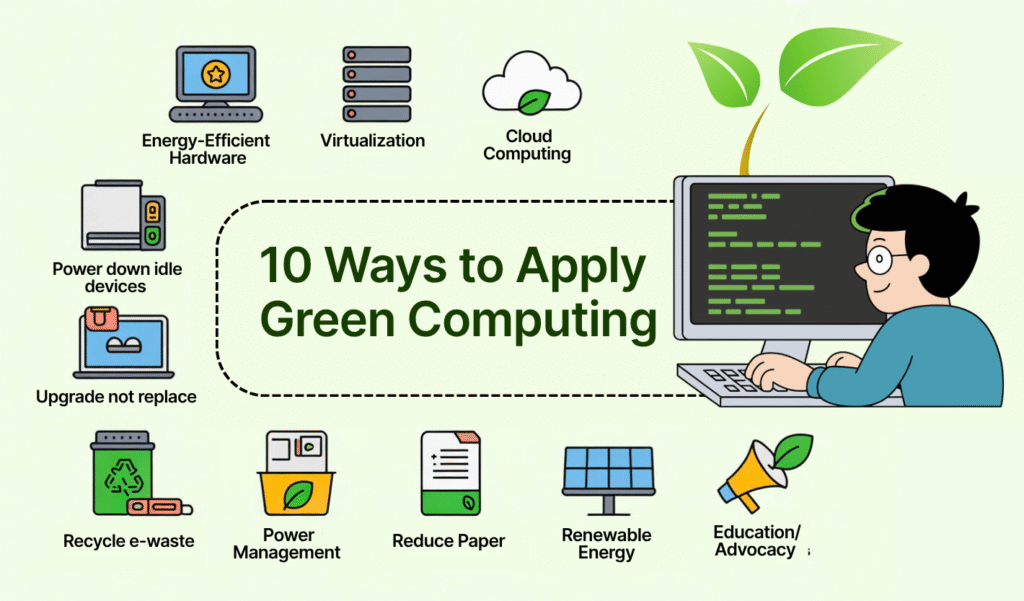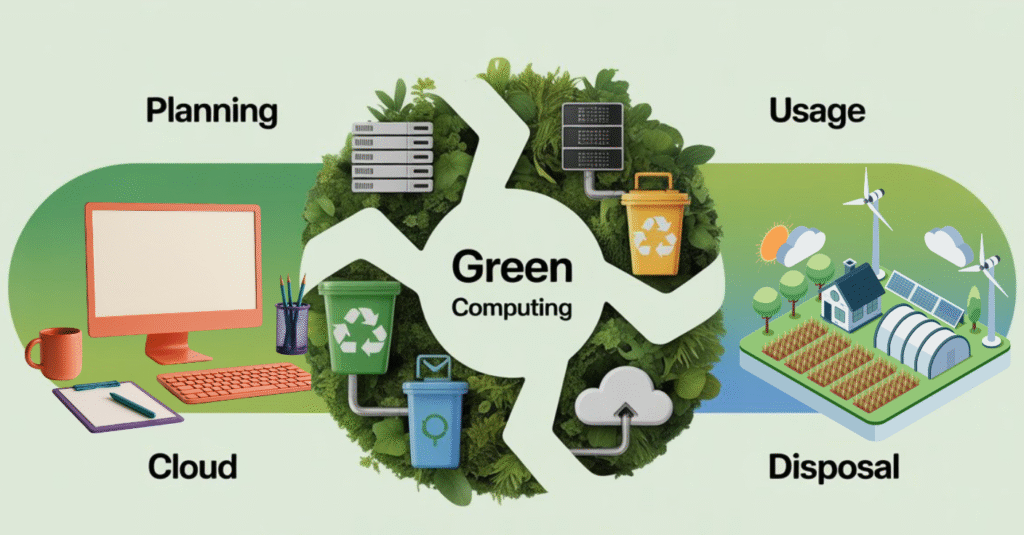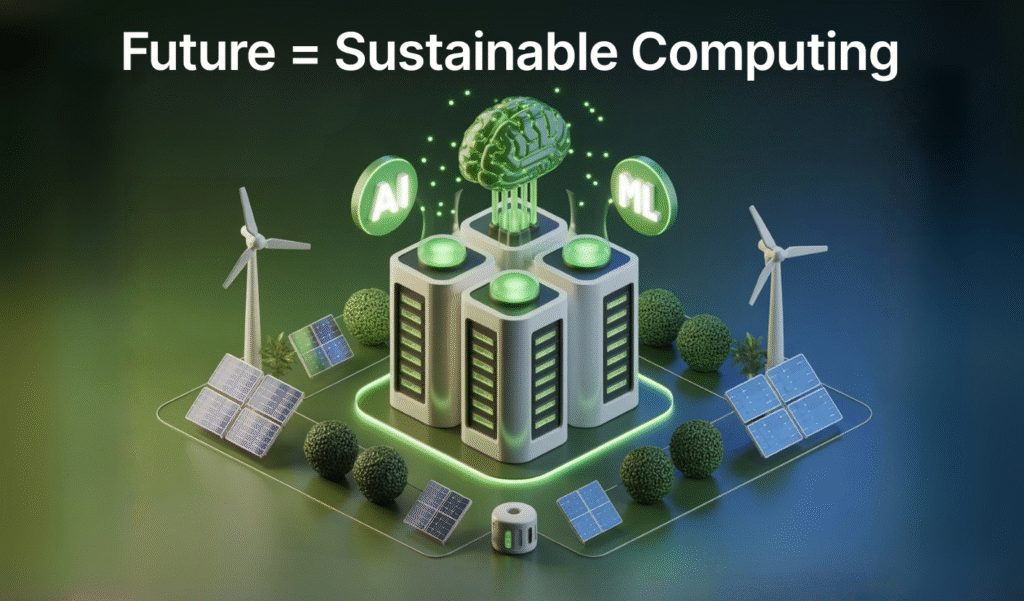

Are you ready to disrupt with AI? Join our Hackathon today! Click to Register
By WebOsmotic Team | Published on December 14, 2024
Summarize Article

Table of Contents
ToggleAs technology changes and progresses, there arises the need to address its negative sides, especially in terms of its impacts on the environment, and that is green computing. Green computing is a recent practice targeting a much lower carbon footprint attached to the technology while maximizing efficiency and sustainability within the particular technology. So, what is green computing, and what importance is attached to it?
This green computing guide will take you along the definition- benefits- most importantly, 10 ways to apply green computing in your daily life or business-. Together, let’s take those first steps to a more sustainably tech-propelled future.
Green computing meaning, simply put, is designing, using, and disposing of computers and related systems such that they fit environmentally. The concepts are simple: conserving energy, reducing e-waste, and creating ways to adopt sustainable computing practices across sectors and households.
Green computing is significant for the following reasons: Every device you use bumps your energy consumption and waste. With such a strategy, let’s take pride in:
This is not a stale statement, but it has borne fruit-the fruit being cleaner air, reducing waste in landfills, and healthier land in the future for generations to come:

Before considering the practical steps, first, let’s get right into the list of benefits of green computing:

With a good understanding of the meaning of green computing, here is its practical side. Here are the ten ways you can green your computing tons today:
Energy-efficient hardware includes newly purchased energy appliances that are qualified by different agencies, such as ENERGY STAR. An energy-efficient appliance saves minimal energy and perhaps no energy when it is on, hence saving energy or bills.
Have you heard of hearing virtualization? It’s the operation of multiple virtual machines on a single physical machine. Consolidating workloads within a new single piece of hardware will, therefore, reduce energy consumption and cooling needs for an organization by effectively eliminating most physical servers.
Another step is to use cloud computing services directed toward sustainable computing initiatives. Well, most cloud providers run data centers that are designed to be power-efficient; instead of running heavy energy on-premises servers, it would be advisable to use the cloud for storage and computing capacity.
Also, plug in your unused printer even if you do not use it. These behaviors encourage the waste of energy. Demand the collection of an electricity shut-off service for electronic devices that have no use or invest in a smart plug so that this process is automated.
First try upgrading the older comp, if it is still working satisfactorily. Sometimes hardware upgrades mainly a hard disk or additional RAM can give a new lease of life to the computer without the environmental costs associated with manufacturing a new device.
Recycling e-waste is a growing challenge. Ensure that every obsolete device thrown into it finds its way to the certified e-waste recycling programs since it will, as a consequence, minimize the amount of harmful materials entering landfills.
Each one of the modern devices has power management options such as sleep and energy savings options. These can lead to a significant reduction of pollution the energy has wasted.
Why print out a document when you can store it on your computer? Engage the workforce into going digital and into the uses of sharing platforms to minimize hard-copy documentation.
If possible, run your tech appliances on renewable energy sources like solar panels. Many big names in the industry are also pledging to use renewable energy sources in their operations check them out.
Share your knowledge! Convince colleagues or employees to go the way of green computing. The more people, the more extensive the impact on the course.

You might ask: so, is it worth it? Green computing has very clear and relevant benefits:

In the same way that technology grows, so will the possibility of greener practices in the industry. It could range from using innovative development like AI and machine learning to optimizing how resources are utilized. There are advancements made in renewable energy power for our devices sustainably.
Green computing strategies might be ultimately commonplace in the future and not an exception. Visualize a world where every device, server, and data center uses as little as possible of the environment; indeed, this would be the vision we would need to strive to achieve.
Green computing is an adoption movement into a future of sustainable existence. Like the adoption of the following 10 ways to apply green computing for one’s carbon footprint reduction as well as monetary saving and even having a healthier planet. Enabling power management features to recycling e-waste and using renewable sources of energy all count in small steps, for both an individual and a business.
Are you ready to reap the benefits of green computing? The future of technology is green—let’s make it happen!
Not at all! Initial investment costs. Energy-efficient hardware is indeed perceived as an expensive investment, however, the savings on energy bills and replacement costs over their entire life cycle dwarf the initial expenses.
That is very possible. They can start by doing simple things like recycling their e-waste, energy-efficient appliances, and power-saving policies.
Software optimization is a major feature of green computing. Software that uses fewer resources means less need for powerful (and power-hogging) hardware.
Unlock exclusive insights and expert knowledge delivered straight to your inbox